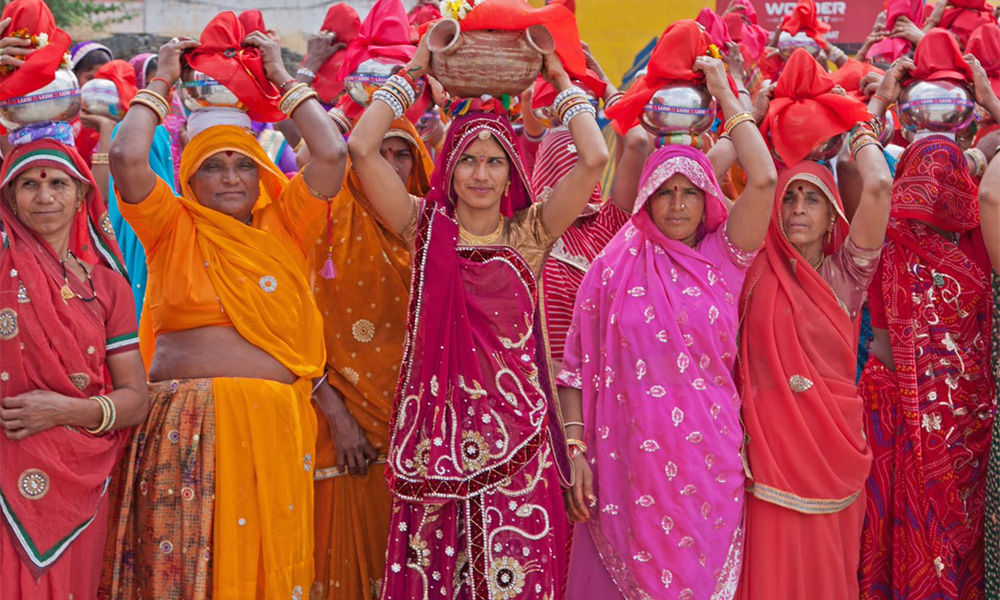The Gangaur Festival, a jubilant and cherished event in Rajasthan, India, epitomizes the essence of love, devotion, and cultural richness. Celebrated with boundless enthusiasm, this festival centers around the worship of Goddess Parvati, representing marital happiness and virtue. Amidst a cascade of vivid colors, heartfelt prayers, and traditional rituals, the Gangaur Festival showcases Rajasthan's profound cultural heritage and unwavering faith.
Gangaur Festival: A Glimpse of Tradition and Joy
The Gangaur Festival is a magnificent tribute to the divine relationship between Lord Shiva and Goddess Parvati, symbolizing the eternal bond of marriage. The term "Gangaur" derives from "Gana," which refers to Lord Shiva, and "Gaur," the embodiment of Goddess Parvati. This auspicious occasion unfurls a tapestry of rituals, melodies, and merriment that reverberate through the desert state.
The Mesmerizing Procession
The streets of Rajasthan come alive with a dazzling procession during the Gangaur Festival. Bedecked women, bedazzled with traditional finery, carry elegantly crafted clay idols of Gauri (Goddess Parvati) in a grand parade. Accompanied by traditional folk musicians and dancers, the procession is a captivating spectacle that offers a glimpse into Rajasthan's captivating culture.
Decked in Elegance: Women's Adornments
Gangaur Festival is synonymous with radiant women elegantly draped in vibrant sarees and adorned with intricate jewelry. From exquisite maang tikkas (forehead ornaments) to ornate bangles and necklaces, the festival showcases Rajasthan's opulent jewelry craftsmanship. The sight of women gracefully adorned adds to the festival's allure.
Craftsmanship of Clay Idols
A hallmark of the Gangaur Festival is the creation of clay idols of Lord Shiva and Goddess Parvati by women. This creative endeavor is a representation of conjugal love and marital fidelity. The idols, meticulously handcrafted and adorned, are displayed with devotion during the festival and later submerged in water as a symbolic ritual.
Enthralling Folk Performances
As the sun sets over the golden sands of Rajasthan, the Gangaur Festival comes alive with vibrant folk performances. Local artists captivate the audience with traditional dances like Ghoomar and Kalbeliya, infusing the atmosphere with an infectious energy. These performances narrate stories of valor, romance, and devotion, adding a cultural dimension to the festivities.
Rituals and Observations
The Gangaur Festival unfolds over several days, each marked by unique rituals. Married women pray for the well-being and longevity of their husbands while unmarried women seek blessings for a suitable life partner. The final day witnesses the immersion of the clay idols in water bodies, symbolizing the culmination of the festival and the departure of the deities.
Rajasthani Cultural Heritage
The Gangaur Festival is a testament to Rajasthan's rich cultural heritage. The intricate rituals, vibrant attire, and heartfelt celebrations encapsulate the essence of the state's traditions. This event not only celebrates the divine but also serves as a vivid representation of Rajasthan's cultural diversity.
Connecting with the Divine: Spirituality and Faith
The Gangaur Festival transcends its cultural significance and delves into the realm of spirituality and faith. The devotion and fervor with which individuals participate in the festivities reflect their unwavering belief in the divine union of Lord Shiva and Goddess Parvati. It is a time when prayers and traditions converge, creating an atmosphere of profound spirituality.
Frequently Asked Questions
What is the significance of the Gangaur Festival?
The Gangaur Festival holds immense significance as it celebrates the divine union of Lord Shiva and Goddess Parvati, embodying marital harmony and virtue.
